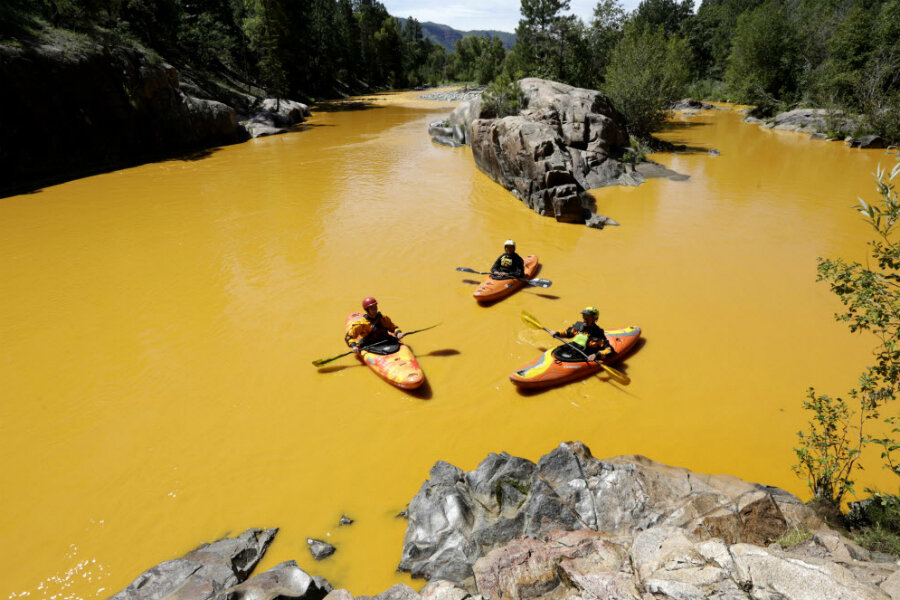Animas River spill: How Colorado's 'Gold Medal' waters turned mustard
Loading...
In 1999, a two-mile stretch of the Animas River, near Durango, Colo., garnered the state's top award issued for trout-friendly, cold-water habitats. But five days ago, these "Gold Medal" waters turned mustard, as a pulse of more than 3 million gallons of contaminated water poured in from an abandoned mine upstream.
The incident occurred as federal environmental workers were moving earth to try to control underground water levels to prevent just such an outcome.
The stunning event may provide a Cuyahoga River moment in the region's long-running struggle to deal with water pollution from abandoned hard-rock mines.
At least that's the hope some environment groups and researchers in the region express as sediment-laden waste water from the Gold King Mine, near Silverton, Colo., flowed south, then west toward an eventual merger with the Colorado River at Lake Powell.
In 1969, the Cuyahoga River became a highly visible symbol of the nation's water pollution problems after its oily surface caught fire and torched a railroad bridge as it wound its way through Cleveland. Images of a river on fire helped propel landmark federal environmental laws, including the Clean Water Act.
The water burst from the Gold King Mine Aug. 5, as the US Environmental Protection Agency was working to control rising water levels inside the mine.
The ensuing flow of polluted water down Cement Creek and into the Animas River has been painful to watch, notes Judith Kohler, spokeswoman for the National Wildlife Federation office in Denver.
For Colorado and much of the western United States, the fouling of Cement Creek and the Animas River "might be a great teaching moment" regarding pollution from abandoned mines, she says.
The water contained lead, cadmium, arsenic, copper, manganese, and iron at levels substantially higher than state water quality standards define as acceptable, according to EPA measurements taken the day after the blowout.
More than 20,000 abandoned mines burrow into Colorado mountainsides, notes Mark Williams, a geographer at the University of Colorado at Boulder who specializes in alpine hydrology and has worked with the EPA on issues related to polluted water from abandoned mines.
One study he and colleagues conducted found that 1,400 miles of streams in the state failed to meet the EPA's water quality standards for wildlife because of mine contamination.
The West as a whole sports some 500,000 abandoned mines, which "all have problems," although the potential for King Gold Mine-size leaks varies, Dr. Williams says.
And where acidic mine drainage might not have been a significant problem for people in the past, that is changing.
Almost all of the West's abandoned mines are high up on mountainsides, giving leaks nowhere to go but down. In Colorado, for instance, most of the valuable minerals are found at elevations between 9,000 and 12,000 feet.
Such rugged, high-altitude terrain once might have buffered people living at low elevations from the effects of mine-water blowouts. But with population growth in a state that is a prime vacation destination, people have been moving to ever-higher elevations.
What wasn't a problem in the past is becoming a problem now because of the increased use of mountain water," Williams says.
Dealing with contaminated water in abandoned mines is challenging for several reasons.
Alpine hydrology dictates that snowmelt and other forms of surface water will find their way into abandoned mine shafts, where cave-ins can set up dams.
And so many mines have punctured mountainsides that trying to establish a mountain's natural plumbing system, in hopes of perhaps diverting water from entering the mines, can be daunting.
The most effective way to deal with the problem at the moment is to treat the water at the mine, then release it to flow through the watershed. But that can cost between $500,000 to $1 million per mine per year, essentially forever.
Politics and public relations also can impede clean-up.
Four years ago, the EPA noted that a group of mines along the upper reaches of Cement Creek were collectively leaking enough contaminated water to qualify as a Superfund site. This would have opened federal coffers to help pay for remediation. But the notion ran into stiff local opposition, in no small part because many people worried that the Superfund label would send tourists elsewhere.
With the current blow-out at Gold King Mine, it's quite likely "that ship has sailed," notes Ms. Kohler.
She notes that this debacle and the broader problem it highlights could encourage support for federal legislation that protects so-called good Samaritans from liability during efforts to clean up old mining sites. These would include nonprofit groups who might want to help undertake cleanup efforts, but who have been discouraged by the EPA with warnings that, in essence, said, "you didn't break it, but you're going to own it," if something goes wrong during remediation efforts, Kohler says.
Concerted efforts to clean up mine contamination can pay dividends, she adds.
For years, the Arkansas River was in tough shape, fouled by mining activities around Leadville, Colo., near the river's headwaters, she explains. Trout were virtually absent from long stretches of river that once teemed with them.
In January 2014, after 20 years of clean-up work, the state designated 102 miles of the river as Gold Medal Waters, where fishing and kayaking once again can flourish.






